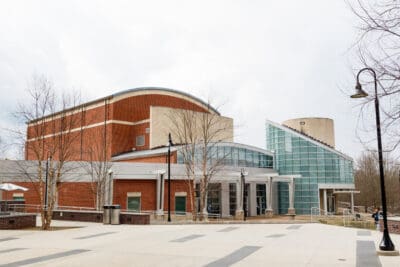

Five Reasons Why Community Colleges Are Key to Our COVID-19 Recovery
June 10, 2020
At a Glance
With the right policies and investments, community and technical colleges would be primed to help the nation get through the public health and economic crisis.
In March, the world changed. COVID-19 hit the nation, impacting the health, economic security, and way of life of many Americans. Education also was severely disrupted. The traditional model of much of higher education is simply at odds with the reality of the pandemic.
With so much at stake, it would be wise to consider what the nation’s public community and technical colleges have to offer for students, workers, and the economy.
Community colleges have been leaders in crisis response throughout our history. Because they emphasize affordability, flexible education delivery, and connections to local communities and regional economies, community colleges are well positioned to provide Americans with access to postsecondary education and prepare them for work. That is why, especially in times of economic downturn, government, communities, and families ought to look to community colleges as engines of recovery.
As community college practitioners serving on JFF’s Policy Leadership Trust, we offer five reasons why community colleges are the right choice at this time, and why investments and policies that support our institutions are essential to combatting the public health and economic crises triggered by the COVID-19 pandemic.
This fall will undoubtedly bring more challenges—and more opportunities. Community colleges should lean into the challenge.
We believe that community colleges can and should play an essential role during the crisis and recovery for the following reasons:
- They train the workforce that is vital for treating the sick and keeping the nation safe
- They specialize in career-oriented programs that can get people (back) to work quickly
- They offer a promising first step for students seeking bachelor’s degrees
- They have deep roots in their local communities
- They have a track record of adapting to changing circumstances and priorities
REASON 1: Community colleges train the workforce that is vital for treating the sick and keeping the nation safe.
COVID-19 has made abundantly clear how important health care workers and first responders are to the well-being of our nation. Many who serve on the front lines of the pandemic received their education and training at community colleges. This spring, the talent development pipeline was thrown into disarray. Colleges, states, and regulatory bodies can take a number of actions to put health care training back on track and ensure that students can realize their career aspirations to care for their communities in this time of great need.
REASON 2: Community colleges specialize in career-oriented programs that can get people (back) to work quickly.
With more than 43 million Americans filing for unemployment insurance in a matter of weeks after the novel coronavirus started sweeping across the country, helping workers find jobs in a pandemic-battered economy will soon become our nation’s top priority. In particular, demand for short-term training is skyrocketing. Since their inception, community colleges have embraced an open-door mission for offering occupational education and training to serve the workforce development needs of business and industry and the skill needs of students and workers. However, community colleges need to adjust to a changing marketplace to remain relevant and responsive to student demands. The Policy Leadership Trust has articulated a vision for what a career-connected postsecondary system could look like, and how policy, funding mechanisms, and accreditation standards would need to evolve to achieve it.
REASON 3: Community colleges offer a promising first step for students seeking bachelor’s degrees.
The prudent decision for many students this fall may be to postpone plans to attend a residential institution and instead enroll in their local community college. Community colleges already serve at the intersection of K-12 and higher education. Yet, more must be done to streamline the path to baccalaureate attainment for two-year transfer students. Otherwise, students attending community college this fall risk losing time, money, and—even worse—hope in pursuit of a bachelor’s degree. Through sound policy action and shared accountability structures, transfer pathways can be expanded in time to help students who start their higher education journeys in community colleges this fall.
REASON 4: Community colleges have deep roots in their local communities.
COVID-19 exposed just how many students are living perilously on the edges of society. Given their mission and commitment to serving their local communities, community colleges are in a good position to holistically serve the needs of students and their families. Evidence shows that students are more likely to persist and complete their courses of study when community colleges partner closely with human services agencies to deliver non-academic wraparound supports. Federal and state policy action is needed to break down silos across government programs, build the capacity of institutions, and increase access to public assistance for students.
REASON 5: Community colleges have a track record of adapting to changing circumstances and priorities.
Throughout their history, community colleges have transformed themselves to respond to the needs of evolving communities and changing times. But their agility is being put to the test as the COVID-19 crisis unfolds. To meet the urgent needs of their students, community colleges have had to overcome many challenges, including the need to transition to remote instruction. This fall will undoubtedly bring more challenges—and more opportunities. Community colleges should lean into the challenge, not just by making small adjustments to courses and programs, but by working to realize longstanding goals to transform the college experience.
Serving at the crossroads of education, work, and personal well-being, community and technical colleges are well positioned to make important contributions to the nation during the public health crisis and the long road to economic recovery. However, we need to enact the right policies and make the right investments to harness and unleash the full potential of community colleges.
JFF’s Policy Leadership Trust has plenty more to say about what needs to be done. In this brief, we elaborate on why community colleges matter, how the COVID-19 crisis has exposed a need for change, and what is required for recovery.
As the crisis continues to unfold, the Policy Trust will continue to share ideas and recommend policies designed to help ensure that all Americans have access to high-quality postsecondary opportunities that lead to economic advancement. Be on the lookout for future blogs and virtual conversations in our Practitioner Insights for Recovery series.
Related Content


Support for California Community Colleges
Support for California Community Colleges JFF works with California’s education leaders to transform community colleges by creating guided pathways that improve the student experience for everyone—from entry to graduation. We aim to transform California’s community…

State Policy Road Map for a Smarter Postsecondary System
Our recommendations are framed in three strategies: Policy Agenda We created a comprehensive reforms agenda framed around three strategies for making postsecondary education work for students and the economy. Our goal is to guide policymakers…

Who You Know Matters More than Ever in the COVID-19 Job Market
May 1, 2020
Policy & Advocacy
We are advancing evidence-based policy to enact changes in the education system and the workforce. Nearly half of U.S. workers are in low-paying jobs. Systemic issues in education, employment, and workforce development prevent millions of…